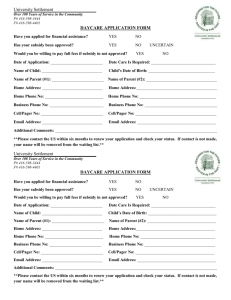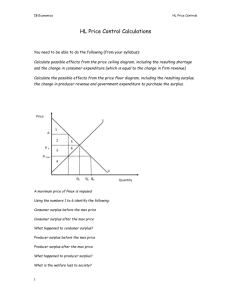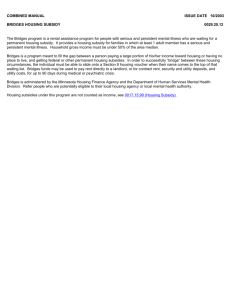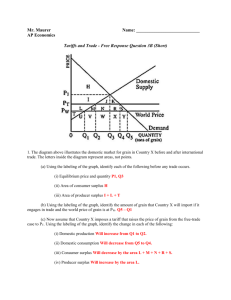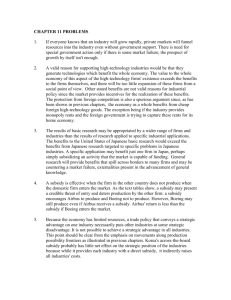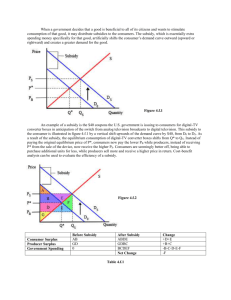Study Questions
advertisement
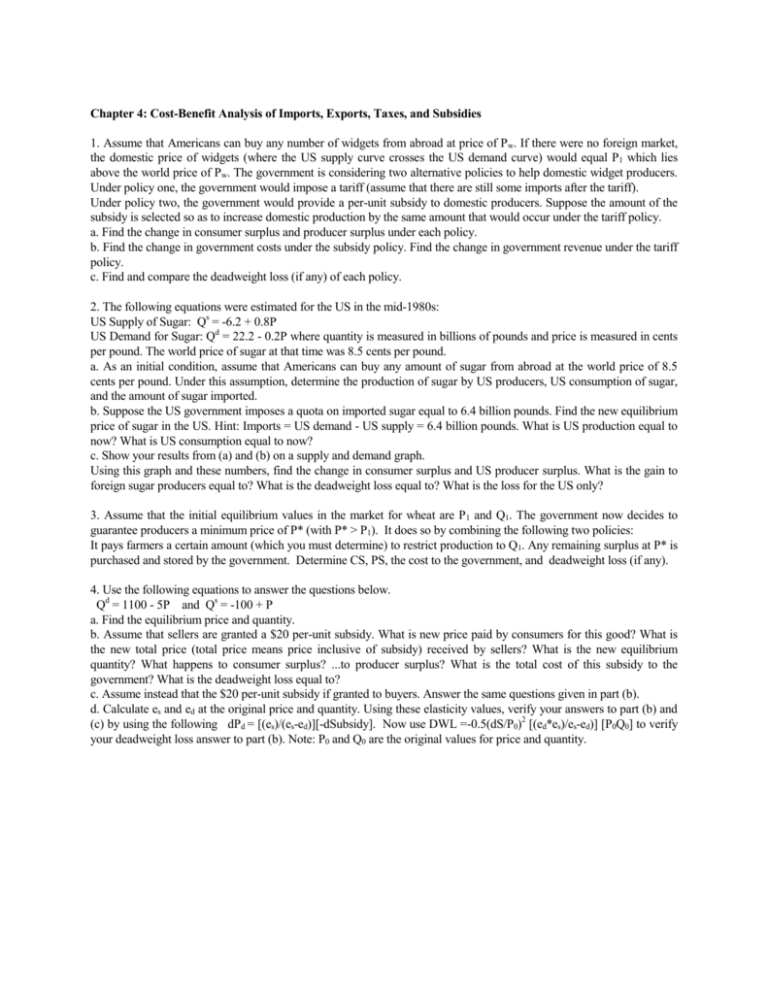
Chapter 4: Cost-Benefit Analysis of Imports, Exports, Taxes, and Subsidies 1. Assume that Americans can buy any number of widgets from abroad at price of Pw. If there were no foreign market, the domestic price of widgets (where the US supply curve crosses the US demand curve) would equal P1 which lies above the world price of Pw. The government is considering two alternative policies to help domestic widget producers. Under policy one, the government would impose a tariff (assume that there are still some imports after the tariff). Under policy two, the government would provide a per-unit subsidy to domestic producers. Suppose the amount of the subsidy is selected so as to increase domestic production by the same amount that would occur under the tariff policy. a. Find the change in consumer surplus and producer surplus under each policy. b. Find the change in government costs under the subsidy policy. Find the change in government revenue under the tariff policy. c. Find and compare the deadweight loss (if any) of each policy. 2. The following equations were estimated for the US in the mid-1980s: US Supply of Sugar: Qs = -6.2 + 0.8P US Demand for Sugar: Qd = 22.2 - 0.2P where quantity is measured in billions of pounds and price is measured in cents per pound. The world price of sugar at that time was 8.5 cents per pound. a. As an initial condition, assume that Americans can buy any amount of sugar from abroad at the world price of 8.5 cents per pound. Under this assumption, determine the production of sugar by US producers, US consumption of sugar, and the amount of sugar imported. b. Suppose the US government imposes a quota on imported sugar equal to 6.4 billion pounds. Find the new equilibrium price of sugar in the US. Hint: Imports = US demand - US supply = 6.4 billion pounds. What is US production equal to now? What is US consumption equal to now? c. Show your results from (a) and (b) on a supply and demand graph. Using this graph and these numbers, find the change in consumer surplus and US producer surplus. What is the gain to foreign sugar producers equal to? What is the deadweight loss equal to? What is the loss for the US only? 3. Assume that the initial equilibrium values in the market for wheat are P1 and Q1. The government now decides to guarantee producers a minimum price of P* (with P* > P1). It does so by combining the following two policies: It pays farmers a certain amount (which you must determine) to restrict production to Q1. Any remaining surplus at P* is purchased and stored by the government. Determine CS, PS, the cost to the government, and deadweight loss (if any). 4. Use the following equations to answer the questions below. Qd = 1100 - 5P and Qs = -100 + P a. Find the equilibrium price and quantity. b. Assume that sellers are granted a $20 per-unit subsidy. What is new price paid by consumers for this good? What is the new total price (total price means price inclusive of subsidy) received by sellers? What is the new equilibrium quantity? What happens to consumer surplus? ...to producer surplus? What is the total cost of this subsidy to the government? What is the deadweight loss equal to? c. Assume instead that the $20 per-unit subsidy if granted to buyers. Answer the same questions given in part (b). d. Calculate es and ed at the original price and quantity. Using these elasticity values, verify your answers to part (b) and (c) by using the following dPd = [(es)/(es-ed)][-dSubsidy]. Now use DWL =-0.5(dS/P0)2 [(ed*es)/es-ed)] [P0Q0] to verify your deadweight loss answer to part (b). Note: P0 and Q0 are the original values for price and quantity. P Question 1 S1US vertical distance equals the per-unit subsidy S2US (with subsidy) SW2 (with tariff) PW+T A B C D E PW SW1 DUS Q1 1. UNDER TARIFF (price = PW+T) CHANGE CS -ABCDE PS +A Revenue to Gov. +CD Social Total -BE Q2 Q3 Q4 Q 2. UNDER SUBSIDY (Price to Buyers = PW and Price to US sellers is PW+Subsidy=PW+T) CS PS Cost to Gov. CHANGE 0 +A –AB -B . . . . The heavy-shaded line is the market supply curve after the per-unit subsidy. Notice that the equilibrium price after the subsidy is still Pw. Since price does not change to consumers, there is no change in consumer surplus. Using the original domestic supply curve, and the fact that US sellers now receive PW+Subsidy=PW+T, we can determine that domestic producer surplus increased by area A. The cost to the government is equal to (per-unit subsidy)(number of units sold by domestic producers) = (PW+T minus PW)(Q2) = area AB. Deadweight Loss is smaller under subsidy program. 2a. USQS=-6.2+0.8(8.5)=0.6 billion pounds, and USQD =22.2-0.2(8.5)=20.5 billion pounds. Imports= USQD- USQS = 20.5 billion pounds minus 0.6 billion pounds = 19.9 billion pounds. b. Imports = USQD- USQS = 6.4 billion pounds. And then by substitution, Imports =[22.2-0.2P]-[-6.2+0.8P]= 6.4 billion pounds. = 28.4-P=6.4 . Solving for P gives us P*= 22 cents per pound. At this price, USQS=-6.2+0.8(22)=11.4 billion pounds and USQD =22.2-0.2(22)=17.8 billion pounds. CS = -ABCDEF= -[(0.22-0.085)(17.8)+(1/2)(0.22-0.085)(20.5-17.8)]=-[$2.40 billion + $0.18 billion]= -$2.58 billion. PSUS = +A= (0.22-0.085)(0.6)+(1/2)(0.22-0.085)(11.4-0.6) = +$0.81 billion. Gain to foreign producers = +CD = (0.22-0.085)(17.8-11.4)= $0.864 billion. Deadweight Loss= -2.58+0.81+0.864= -$0.91 billion. US loss ONLY= -2.58+0.81= -$1.77 billion. P(cents per pound) SUS SUS+quota PW*=$0.22 C A B D E F PW=$0.085 Sworld S QUSinitially= 0.6 S QUSafter=11.4 Imports before quota mports after quota Note 1: Graph not drawn to scale. Note 2: Q is in billions of pounds. D QUSafter=17.8 DUS QUSinitially= 20.5 D Question 3 Price S2 S1 A P* D E B C P1 G F H QD D Q1 Quantity The cost to the government would include both the cost of paying farmers to restrict production to Q1 (area E) plus the cost of buying up the remaining surplus at P* (area CDGH). CS PS Cost to Gov. Social Total Before ABC FG 0 After A BCDEFG -CDEGH Change -BC +BCDE -CDEGH -CGH 4.a. Set quantity supplied equal to quantity demanded and solve for P: 1100-5P =-100+P which gives us P= $200. Q = 1100-5(200)= 100. b. Step one. Since the subsidy is granted to the sellers we determine that Ps=Pd+$20. Step two. We now write the supply and demand functions as: Qs=-100+Ps and Qd = 1100-5Pd. Step three. Substitute Ps=Pd+$20 into the supply function to get Qs=-100+(Pd + 20)= -80 + Pd. (The new supply curve). Notice that the vertical gap between the two supply curves equals per-unit subsidy of $20. (See graphs on next page) Step four. Using this new supply function, set quantity supplied equal to quantity demanded and solve for Pd. Thus, -80 + Pd = 1100-5Pd, and this gives us Pd = $196.67. Step five. Find Ps and Q. Ps=Pd+$20 = 196.67+20=216.67. Q=-80+196.67=116.67. Change in consumer surplus = ABDEF minus AB = +DEF (the letters refer to the graphs on next page)=(200196.7)(100)+ ½ (200-196.7)(116.7-100)=$357.6. Change in producer surplus =BCDH minus DH = +BC=(216.7-200)(100)+ ½ (216.7-200)(116.7-100)=$1,809.5 Cost to Gov. = -BCDEFG= (20)(116.7)= $2,334 Change in Social Total= -G= -$167. c. 1st, note that Pd = Ps –20. 2nd, We write the supply and demand functions as: Qs=-100+Ps and Qd = 1100-5Pd. 3rd, Qd = 1100-5Pd= 1100-5(Ps –20) = 1200-5Ps. 4th, set supply equal to demand and solve for Ps, 1200-5Ps = -100+Ps, which gives us Ps = 1300/6= $216.7. Finally, Pd = Ps –20= 216.7-20=$196.7. Quantity is again equal to 116.67. d. es = (dQs/dP)(P/Q) = (1)(200/100)=2 and e d = (dQd/dP)(P/Q) = (-5)(200/100)=-10. dPd = [(es)/(es-ed)][-dSubsidy].= [2/12][-$20]= -20/6= -$3.3. That is, the price paid by consumers falls by $3.3. This confirms the answers above, dPd = 200-196.7=3.3. DWL =-0.5(dS/P0)2 [(ed*es)/es-ed)] [P0Q0] = -0.5[20/200]2 [(-20)/(12)][200*100] 2 =-0.5[1/10] [-10/6][20,000]= $167. Figure 1(question 4b) Figure 3 P 220 P S1 S2 A Ps=$216.7 P1= $200 Pd=$196.7 S2 S1 P2=$13 B D C E G F P1=$10 H D2 D1 D1 Q1 100 116.7 Q Figure 2 (for question 4c) P 220 P gap=$3 S2 $13 P2 $12 B C S1 G $10 D Pd=$196.7 Figure 4 S1 A Ps=$216.7 P1= $200 Q E F gap = $2 D2 D2 D1 100 116.7 D1 Q Q1 Q2 Q

